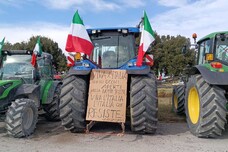Transhumance, the traditional
farming practice of seasonal migration of livestock along
storied tracks towards better climate conditions, was
unanimously inserted Wednesday into UNESCO's list of of
intangible cultural heritage.
The successful bid was made by Italy, Austria and Greece.
With this new inclusion, Italy has overtaken Turkey and
Belgium into top spot for rural and agri-food citations.
Some of the talismanic places include Trentino, Amatrice,
Irpinia, and Puglia.
Transhumance - literally, "crossing ground" - sees herders,
often on horseback and accompanied by dogs, drive sheep and
sometimes cattle across the country in search of seasonal
pastures.
The tradition isn't unique to Italy, but the country remains
one of the few in Europe to have preserved its ancient network
of transhumance routes, some of which are still used by herders
today.
Italian transhumance follows established paths, known as
tratturi, that lead from the mountains where animals graze in
summer to lowlands where they can escape the winter snow.
It is most closely associated with central and southern
Italy, where four main routes run through Abruzzo, Lazio, Molise
and Puglia. Known as the Royal or King's Pathways, they were
protected by rulers in the late Middle Ages but date back far
longer.
The custom also exists to a lesser extent in Italy's northern
Alps, notably Lombardy and South Tyrol.
The practice helped shaped the land, with settlements
springing up along the routes and swathes of Puglia - the most
common winter destination - being cleared for grazing. It also
contributed a rich tradition of folklore, songs and literature.
"Transhumance as a cultural force, with a strong element of
identity, has managed to create strong social and cultural bonds
over the centuries between the people practising it and the
places they pass through, as well as representing a sustainable
economic activity characterized by a special relationship
between man and nature whose symbolic force has influenced all
fields of art," the Ministry of Agriculture said in filing the
application.
I Pastori - The Shepherds - a poem by early 20th-century
Abruzzo-born 'bard' Gabriele d'Annunzio, celebrates the autumn
migration towards the sea.
While transhumance has come close to dying out in modern
times, some herders remain committed to keeping it alive. Laws
to protect the trails were introduced in the 1970s, though many
of them suffer from a lack of maintenance.
Tourism has helped the tradition survive, with some
agrotourism associations offering visitors the chance to join
shepherds on their summer trek.
Italy's last contribution to the world's intangible heritage,
as defined by the UN's cultural body, was the Neapolitan art of
pizza making. Traditional "pizzaiuolo" was added to Unesco's
list in December 2017 after a passionate campaign by Naples'
pizza chefs.
There has also been talk of submitting gelato, Italy's
superlative ice cream, for Unesco heritage status, though no bid
has yet been presented.
ALL RIGHTS RESERVED © Copyright ANSA











